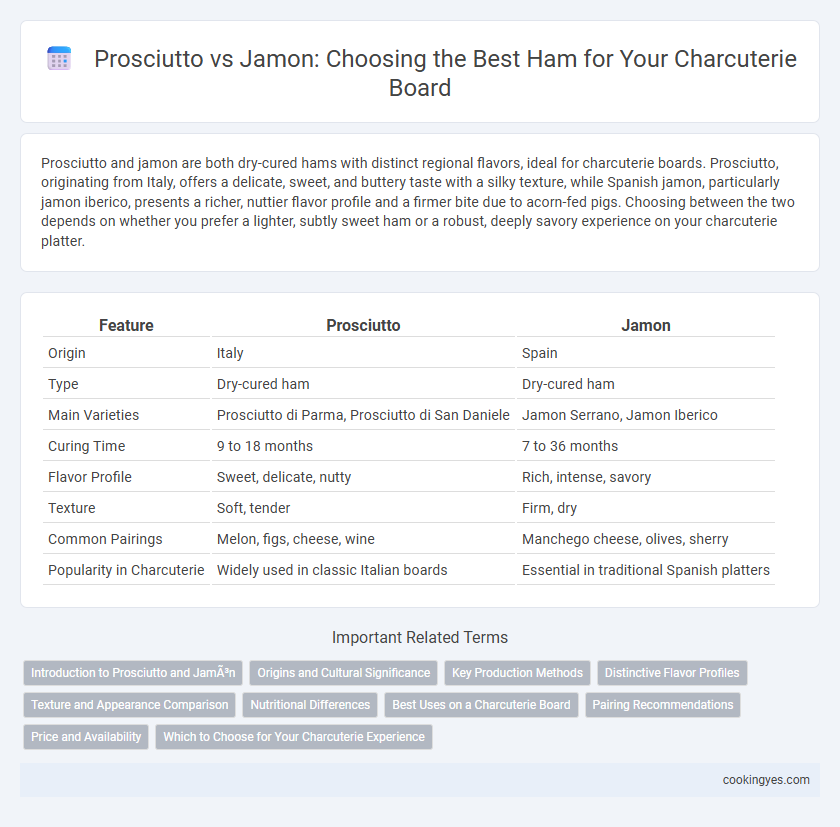Prosciutto and jamon are both dry-cured hams with distinct regional flavors, ideal for charcuterie boards. Prosciutto, originating from Italy, offers a delicate, sweet, and buttery taste with a silky texture, while Spanish jamon, particularly jamon iberico, presents a richer, nuttier flavor profile and a firmer bite due to acorn-fed pigs. Choosing between the two depends on whether you prefer a lighter, subtly sweet ham or a robust, deeply savory experience on your charcuterie platter.
Table of Comparison
| Feature | Prosciutto | Jamon |
|---|---|---|
| Origin | Italy | Spain |
| Type | Dry-cured ham | Dry-cured ham |
| Main Varieties | Prosciutto di Parma, Prosciutto di San Daniele | Jamon Serrano, Jamon Iberico |
| Curing Time | 9 to 18 months | 7 to 36 months |
| Flavor Profile | Sweet, delicate, nutty | Rich, intense, savory |
| Texture | Soft, tender | Firm, dry |
| Common Pairings | Melon, figs, cheese, wine | Manchego cheese, olives, sherry |
| Popularity in Charcuterie | Widely used in classic Italian boards | Essential in traditional Spanish platters |
Introduction to Prosciutto and Jamón
Prosciutto and Jamon are two iconic types of dry-cured ham, each with distinct characteristics rooted in Italian and Spanish culinary traditions. Prosciutto, particularly Prosciutto di Parma, is known for its delicate, sweet flavor and tender texture achieved through a lengthy curing process using only sea salt. Jamon, including varieties like Jamon Iberico and Jamon Serrano, offers a richer, more intense taste profile, influenced by the breed of pig and acorn-based diet for Iberico hams.
Origins and Cultural Significance
Prosciutto hails from Italy, renowned for its delicate texture and sweet, nutty flavor developed through air-drying, specifically in regions like Parma and San Daniele. Jamon, a staple of Spanish cuisine, features a richer, more robust taste, with famous varieties like Jamon Serrano and Jamon Iberico reflecting Spain's diverse terroirs and traditional curing methods. Both hams hold deep cultural significance, symbolizing regional pride and artisanal craftsmanship in their respective charcuterie traditions.
Key Production Methods
Prosciutto is dry-cured using sea salt and air-dried for 9 to 24 months, primarily in Italy, resulting in a delicate, sweet flavor and tender texture. Jamon, particularly Jamon Iberico, undergoes a longer curing process often exceeding 24 months, involving salting, resting, and aging in specific climate-controlled cellars in Spain, which yields a complex, nutty taste and firmer bite. Both hams use traditional craftsmanship, but variations in curing time, climate, and pig breed significantly influence their distinctive flavor profiles suitable for charcuterie boards.
Distinctive Flavor Profiles
Prosciutto offers a delicate, sweet, and nutty flavor with a buttery texture, resulting from its slow curing process in Northern Italy. Jamon, especially Jamon Iberico, presents a complex, savory, and slightly earthy taste with rich marbling and a firmer bite, influenced by acorn-fed pigs in Spain. These distinctive flavor profiles make prosciutto ideal for light, subtle pairings, while jamon complements robust cheeses and bold wines on a charcuterie board.
Texture and Appearance Comparison
Prosciutto features a delicate, silky texture with thin, translucent slices that showcase its pale pink color and fine marbling, ideal for elegant charcuterie boards. Jamon, particularly Jamon Iberico, offers a firmer, meatier bite with a deeper red hue and more pronounced fat veins, adding a rustic visual appeal. The contrasting textures and appearances of prosciutto and jamon enrich charcuterie presentations, catering to diverse taste and aesthetic preferences.
Nutritional Differences
Prosciutto and Jamon differ in nutritional content primarily due to their curing processes and regional practices; Prosciutto typically contains slightly higher fat content, averaging around 10-15 grams per 100 grams, while Jamon Iberico, especially from acorn-fed pigs, offers richer monounsaturated fats with approximately 8-12 grams per 100 grams. Protein levels in both hams are comparable, generally ranging from 25 to 30 grams per 100 grams, contributing to their high-protein profile ideal for charcuterie boards. Sodium levels are notable in both, averaging 1000-1600 milligrams per 100 grams, reflecting the extensive curing and seasoning methods essential for preservation and flavor development.
Best Uses on a Charcuterie Board
Prosciutto offers a delicate, buttery texture ideal for pairing with creamy cheeses and sweet fruits on a charcuterie board, enhancing flavor contrast. Jamon, particularly Jamon Iberico, provides a rich, nutty taste with a firmer bite that complements robust cheeses and olives. Both hams elevate the board's visual appeal and flavor complexity, but choosing between them depends on desired flavor intensity and texture balance.
Pairing Recommendations
Prosciutto pairs exceptionally well with sweet fruits such as melon and figs, alongside mild cheeses like mozzarella or burrata, enhancing its delicate, salty flavor. Jamon, particularly Jamon Iberico, complements nutty notes and rich cheeses like Manchego, while Spanish wines like Tempranillo amplify its intense, savory profile. Both hams benefit from crusty bread and olives, creating balanced charcuterie boards with contrasting textures and flavors.
Price and Availability
Prosciutto and Jamon differ notably in price and availability on charcuterie boards. Prosciutto, especially varieties like Prosciutto di Parma, tends to be more widely available and moderately priced in international markets due to extensive production and export. Jamon Iberico, particularly the high-quality Jamon Iberico de Bellota, is pricier and less accessible outside Spain, reflecting its artisanal curing process and limited regional production.
Which to Choose for Your Charcuterie Experience
Prosciutto and Jamon each bring distinct flavor profiles and textures to a charcuterie board, with Prosciutto offering a delicate, sweet, and silky taste from northern Italy, while Jamon, especially Jamon Iberico from Spain, provides a rich, nutty, and complex flavor due to acorn-fed pigs and extended curing. For a refined charcuterie experience, Prosciutto pairs well with mild cheeses and fruits, enhancing subtle taste layers, whereas Jamon complements robust cheeses and olives, elevating savory depth. Choosing between them depends on whether you prefer the elegant softness of Prosciutto or the intense, earthy aroma of Jamon to best match your overall selection and presentation.
Prosciutto vs Jamón for Charcuterie Infographic

 cookingyes.com
cookingyes.com